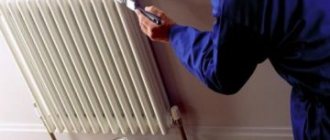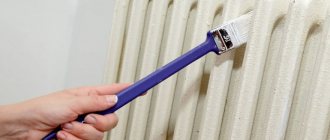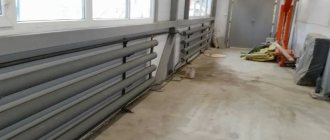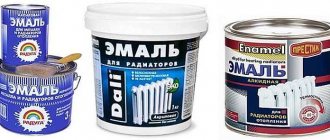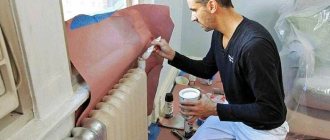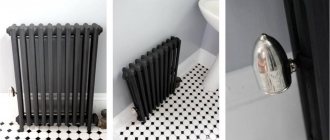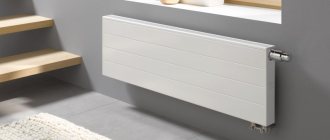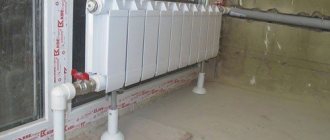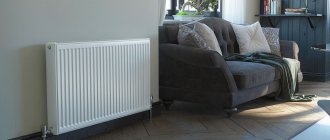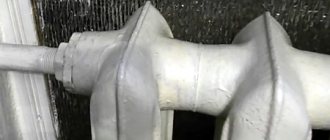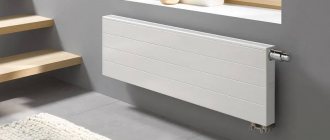When repairing there are no trifles, all details deserve attention, including heating radiators, which are an integral part of any home. Batteries must correspond to the overall interior, harmonize with it and support its mood. In order for them to serve for many years and at the same time look neat, it is necessary to provide them with regular and proper care.
Radiators should be coated only with high-quality paints and varnishes that are resistant to high temperatures. A well-chosen composition does not peel off or spread, and its reliability does not raise questions. Let's try to understand all the intricacies of choosing enamel for radiators, and whether they can be used to paint hot radiators.
How to dilute with water
In its original form, acrylic paint has a thick consistency, so it needs to be diluted. For this, special solvents or products recommended by the manufacturer are used.
However, you can use a simple and affordable means for dilution - water. This component is initially included in the composition, so it does not disturb the texture and makes the consistency convenient for application.
It is important to understand that the proportion of water must be strictly observed so as not to spoil the original properties. In addition, for the intended purposes you will only need clean and cool water, without additional impurities.
In painting work, four types of dilution proportions are used:
Ratio 1:1. If you add water in equal quantities to the volume of paint, you will get a consistency suitable for applying a base coat. The liquid will be thick, but will not stick to the roller or brush and will lie evenly over the surface.
Ratio 1:2. If you add two parts of water to one part of paint, you get a composition of a mobile consistency, creating a thin layer on the surface to be painted. Used on smooth surfaces to reduce the intensity of dark colors.
Ratio 1:5. If the amount of water added 5 times the volume of paint, a liquid composition is obtained - tinted water, which will penetrate between the fibers of the working tool. When applied, a barely noticeable layer is formed, which will look interesting when painting textured surfaces.
Ratio 1:15. In this case, the result is ordinary water with a small amount of dissolved dye. This composition is used to create smooth transitions between shades and gradient color designs.
Measure the required amount of water with a syringe or measuring cup to maintain the recommended proportions.
Be careful: you need to dilute acrylic paint with small portions of water, adding gradually. In this case, you cannot stop stirring.
Diluting acrylic paints with water
The basis of acrylic paints and varnishes is water, so it is advisable to use it to achieve the required consistency. An important point: you need to use only clean and cold water, standing for several hours or distilled, to prevent interaction between the components of the paint and varnish material and the thinner.
- dilution with water 1:1 - the material can be used to create a base layer, the paintwork lays down smoothly, without smudges or sagging, forming a uniform coating that effectively protects the surface from corrosion and aggressive environmental influences;
— 1:2 – the consistency is more liquid, allowing you to create a thin and even layer, the paintwork material saturates the brush or roller well;
– 1:5 – creates “colored water”, which is used to color textured details; the composition is well absorbed and fills depressions and other depressions on the surface;
— 1:15 – the proportion is not used often, it is intended to create a transition between tones (gradient); in fact, it is no longer paint, but colored water.
After applying acrylic water-based paint and varnish material, you must immediately thoroughly clean the tool used. This is explained by the fact that after drying, water-based acrylic paintwork becomes water-resistant. And, accordingly, rollers, brushes and other painting tools, once dry, cannot be cleaned.
How to dilute with solvents
In 90% of cases, solvents are colorless, with a distinct specific odor. These products are used to change the texture of acrylic paints and obtain a matte or glossy surface. Unlike water, which can add “cloudiness” to the color, special thinners do not have such a negative effect.
The proportions of adding such funds depend on the type of proposed work. If there is a lot of solvent, the texture will become translucent; if there is little solvent, the thick, rich color will remain. Manufacturers give recommendations for dilution, follow them.
The use of solvents depends on the air temperature.
When painting in cold weather, use solvents with a high drying speed to ensure the paint has good adhesion to the surface.
At normal temperatures, use compounds with an average drying speed. They are considered universal and suitable for all types of work.
Slow drying solvents are designed for hot weather and prevent water from evaporating too quickly.
It is important to understand that a properly selected solvent improves the performance characteristics of the composition, affects the strength of the coating and color saturation.
Solvents that are compatible with acrylic paints:
gasoline and white spirit - compositions with a high drying rate;
kerosene – average volatility value;
turpentine - slow evaporation.
There are positive reviews about RELOCRYL ACRYL , which is designed specifically for diluting acrylic paints, varnishes and primers.
If the composition gets on a surface not intended for painting, it is washed off using a solvent remover. The composition is available in the form of a paste. It is applied to the desired area and left for 10-15 minutes . The remover dissolves the acrylic and excess is easily removed.
Regardless of the chosen option, it is important that two rules are followed - the resulting solution should not coagulate, and the presence of lumps is unacceptable.
Dilution with special acrylic thinners
Dilution with water or water with alcohol is only permissible when using a roller or brush. Paint sprayers and spray guns (painting equipment) require the use of acrylic thinners, the brand of which must be indicated by the manufacturer on the packaging. They have a specific smell and transparent appearance. The required amount of addition of such liquid depends on the scope of application, temperature and humidity of the external environment. Depending on the composition, acrylic solvents create a matte or glossy layer on the surface. Different coloring effects are achieved using a certain proportion, which is usually indicated on the thinner packaging.
Advantages of using acrylic solvent:
— accelerated drying time;
— the ability to create a matte or glossy surface;
— formation of an even layer without smudges and white deposits;
— chemical purity, compared to water;
— increased stability of paint characteristics.
What to do if the paint has dried
It is impossible to accurately calculate the amount of material needed, so professional builders prefer to take it in reserve. After interior finishing, there are situations when some amount of paint remains unused.
The remainder in the jar gradually dries out - the moisture evaporates over time, and polymerization begins. The more liquid “leaves”, the lower the performance characteristics of the composition.
You shouldn’t immediately throw away the damaged material: you can try to revive the paint, returning it to its original properties.
Instructions for restoring dried paint.
Grind the remains into powder with a minimum fraction.
Pour boiling water over for 2-3 seconds , then drain.
Repeat the procedure 2-3 times so that the composition warms up.
Leave the boiling water in the jar and mix the contents thoroughly until smooth.
If the paint has turned into a homogeneous plastic lump, proceed as in the previous case. But at the final stage of resuscitation, add alcohol instead of hot water. Regular women's nail polish, added a little at a time, can also help.
If finances allow, buy acrylic thinner "Gamma" . It is inexpensive, but does an excellent job with paint that has acquired a “rubber” consistency. The product is sold in online stores and specialized retail outlets.
The performance properties of the restored material will be lower than the original ones - the lumps will not completely dissolve, which will negatively affect the strength of the coating. Use this composition for painting minor surfaces that are not noticeable.
If acrylic paint has deteriorated after improper storage, for example, at subzero temperatures, it cannot be restored. In such a situation, irreversible polymerization of the material begins, various substances will be powerless.
More about paint properties
- Brightness and color saturation.
- Acrylic paint dries quite quickly due to its water base.
- Dense and uniform surface coverage.
- Persistence. When applied, the water evaporates quickly, leaving behind a durable synthetic substance and pigment. They firmly bond the paint to the surface.
- Retains color when dried and exposed to sunlight.
- Strength of structure and resistance to external irritants.
- Water-repellent property. Acrylic paints are not affected by moisture after drying.
Additional recommendations
Working with acrylic paints has nuances and secrets. Here are some of them:
The water must stand for 2-3 hours so that the impurities settle to the bottom. Only after this can it be used to dilute acrylic paints.
When applying the composition using a spray gun, work with branded solvents, adhering to the proportions recommended by the manufacturer. This way you will get a liquid of uniform consistency and achieve uniform coloring of the surface.
Rinse brushes and rollers thoroughly, especially if the work was performed with a highly diluted liquid. This composition is difficult to notice, so the particles remain between the villi. If you subsequently use paint of a lighter shade, the color will be spoiled.
Add the diluent to the composition in portions, thoroughly mixing the composition after each dose. To do this, use a special mixer.
It is not recommended to purchase the material “back to back” - it is advisable to leave a small amount of paint unused. This is necessary for spot restoration of the surface in case of accidental damage.
Regardless of what you choose to thin your acrylic paint with, test the product with a small amount of colorant. If you notice the formation of lumps, you will have to choose another option.
When renovating residential or industrial premises, almost every person wants to choose high-quality consumables that are safe for health and have good performance. A particularly important issue in this matter is the choice of paint for radiators. The difficulty is that if it is chosen incorrectly, it will take quite a long time for the treated surfaces to dry completely. Then, when the radiators are heated, the room will constantly be filled with a pungent and unpleasant odor, and the layer will easily peel off.
Types of paints for batteries
Today, many manufacturing companies offer a fairly wide range of products such as odorless paint for radiators. Thanks to this, buyers have the opportunity to choose the most suitable type for themselves:
- Acrylic enamel;
- Alkyd enamel;
- Oil enamel;
- Water based.
All types differ from each other in production technology, composition and characteristics.
Acrylic enamel
- have no characteristic odor and are excellent for interior work.
- Their widespread use in everyday life is also due to the fact that they dry quickly .
- are characterized by increased moisture resistance ,
- uniform application on any surface,
- and are also absolutely safe for people.
- Due to the fact that the substance contains special additives, the paint layer does not begin to crack and turn yellow when the temperature of the radiator or battery increases.
- In addition, it should be noted that manufacturers offer a huge range of colors , so acrylic paint for heating radiators is often used when decorating surfaces.
Learn more about how to clean soot from a boiler at home: step-by-step instructions here.
As for the disadvantages, the most significant of them is the high cost . However, it fully corresponds to the good performance qualities of the paint.
Alkyd enamel
Alkyd paints, manufactured using the latest technologies, have the following advantages:
- A surface covered with a layer of such a substance is resistant to elevated temperatures - it does not crack when heated to 120 0 C ;
- High strength ;
- Homogeneous layer structure during application;
- Good resistance to abrasion when operating radiators and radiators;
- A wide range of colors allows you to choose almost any color;
- The layer maintains its integrity for a long time.
However, in addition to the advantages, there is also a disadvantage - for several days after painting, an unpleasant odor , which may subsequently appear if the heating is strong enough. In addition, some brands sometimes fade a little and may also change shade.
Water based enamel
Odorless, water-dispersion paint for hot radiators is an excellent option for coating radiators. It differs from other types in a number of features:
- It is made from ordinary water, so it is absolutely safe for people and the environment;
- Special dispersed particles are not harmful ;
- No unpleasant odor;
- It takes very little time to dry completely ;
- Apply easily and evenly;
- Thanks to the water-repellent effect, painted batteries can be washed without destroying the layer;
- Suitable for use in a wide variety of spaces .
The disadvantage is that the color range is not very diverse , because it is mostly only white.
Oil enamel
Oil products are in quite high demand due to a number of their advantages:
- No sharp and unpleasant odor after application and further heating of batteries and radiators;
- They are divided into colored and colorless ;
- Easy to apply to metal surfaces;
- Form a uniform layer ;
- Excellent for use inside both residential and non-residential premises;
- Low cost compared to other types of battery paints;
- Can be used for artistic decoration of surfaces - applying patterns and complex designs.
The downside is that it takes a very long time . This is due to the fact that a solvent is added to the paint.
A little about acrylic paints
This material has a synthetic base and has been on store shelves and in the everyday life of artists, designers and decorators for about 50 years. Its composition is extremely simple: water, pigment and a binder - acrylic polymer emulsion or resin. These paints are known for their special qualities:
- They are easy to apply to the surface.
- They have high covering power.
- They are durable and do not change color after the base evaporates, which is why they are loved by everyone - from amateurs to professionals. This paint sets very firmly, tightly.
In addition, thanks to their synthetic base, these paints are fireproof and ethical, as they do not contain animal products.
The disadvantages include the cost. Acrylic paints are more expensive than gouache, so they are not used very often for painting. Acrylic is mainly used for illustrations, clothing decoration, home decoration and other decorative works. The substance is also difficult to wash off hands and surfaces due to its adhesive properties, and it is difficult to reanimate after the paint has dried.
How to choose the right paint for radiators?
A wide range of different brands leads to the fact that buyers are faced with the problem of which paint to choose. Therefore, when choosing, you must pay attention to whether the enamel meets the following requirements:
- lie flat on metal products;
- Provide protection against rust and corrosion damage;
- Withstand elevated temperatures ;
- Maintain the original color for a long time.
In addition, it is also necessary to take into account what material the batteries and radiators are made of. After all, they can be made from a variety of metals, as well as their alloys. Experts recommend following several tips:
- For devices made of steel, aluminum and bimetallic composition, it is better to use acrylic or alkyd paints;
- except oil-based for cast iron batteries . However, in order for the substance to lay down in an even and thin layer, it must be mixed with a thinner;
- It is better to refuse to use oil paints, even of the most famous brands, because they very rarely perform protective and decorative functions at the same level as others
Comparison with oil paints
Acrylic paints, like oil paints, are a covering material. They are applied to the surface in a similar way and have many similarities when mixing different colors with each other. However, despite their similarities, they have many differences.
Acrylic dries faster because water evaporates more easily and more intensely than oil paints, which can take several days to several weeks to dry. It is not sensitive to changes in temperature and humidity, as well as to the amount of sunlight. Acrylic paints are much stronger. They do not fade, crack or crumble over time, making them suitable for construction work and for decorating clothing and home exteriors.
How to paint correctly?
There are two ways to apply the product: over an existing coating or from scratch. In both cases, the entire process is performed in two steps:
- Preparatory work;
- Application of the substance.
Preparation
In the first case, it is necessary to knock off the crust of their old enamel over the entire surface and in hard-to-reach places, performing the so-called sanding. After removing the old paint from the radiators, they should be treated with a rust converter. If there is no coating on the surface, then it must first be pre-cleaned of residual grease, dirt and dust so that they do not distort the color of the freshly applied layer, and then coated with an anti-corrosion compound.
To obtain the highest quality result, the preparatory work should be done in the following order:
- The old layer is deleted ;
- Places with rust are carefully cleaned until a metallic sheen appears;
- The entire surface is sanded using sandpaper;
- The product must be degreased with white spirit or a slightly alkaline solution ;
- A primer is applied to protect the metal from corrosion.
Painting
Before you begin directly painting the batteries, you need to ensure the appropriate conditions.
- So, the device must be turned off ,
- of its surface should be the same as in the room, but not lower than 15 0 C. Otherwise, the base will not dry and will not be able to polymerize.
- In order for the result to have a neat appearance, the radiator or battery must be removed .
- To reliably protect the surface from corrosion, the internal surfaces, back panel, and lower parts of the slats .
- Painting begins from the inner ribs , rubbing the substance well with a brush. In this case, you need to make sure that no drips appear.
- After everything has dried, they again and the front panels are also captured . It is better to apply the paint in several layers so that there are no gaps.
- After this, the device should not be connected for 5-12 hours so that the enamel has time to completely polymerize. If the work is done correctly, the result will last for about five years .
The need to paint heating appliances
Heating radiators are an integral element of any home. When they are new, they look attractive and harmonize with the interior without standing out against its background. However, over time, the paint on them fades and swells, and in this state the batteries look unsightly and attract attention. The most radical solution to this problem is to replace the heating radiators. However, this is too troublesome and expensive, and also impractical if the batteries are working properly. A cheaper and more practical solution is to repaint the radiators. To do this, use paint that is specially designed to protect the surface of heating radiators from corrosion, giving them a decent appearance and the desired color. Since this problem can be solved using different types of paint, you need to choose the most suitable one among them. This concerns not only and not so much the color of the paint, but its composition.
Prices and reviews
The cost of paint, which is odorless and suitable for heating radiators and radiators, is influenced by its type and brand, as well as its main characteristics.
The price of a 2.5 kg is:
- Enamel for heating batteries of the brand “VDAK 1179” costs 600-670 rubles ;
- Rogneda brand , produced, costs approximately 570-650 rubles ;
- “Dufa Heizkorperlack” – 1500-1700 rubles ;
- "Tex" costs 1100-1270 rubles ;
- Enamel for Tikkurila Thermal will cost approximately 2900-3300 rubles ;
- Alpina Heizkorper brand costs about 1300-1450 rubles .
Despite the fact that all of the above brands are widely used in the construction industry, some of them are much more popular than others. This difference is due to the fact that they are different types and differ from each other in characteristics and properties. That's why they get different reviews.
Most users prefer acrylic or alkyd enamel , noting:
- their resistance to abrasion and cracking,
- as well as ease of maintenance of painted surfaces.
- In addition, they are attracted by a wide range of colors.
about oil-based and water-dispersed paint are also mostly positive, but they often note:
- poor selection of shades and
- Drying period is too long.
Anatoly : “When I recently had to decide what paint to paint odorless radiators with, I chose acrylic enamel. I applied it with a regular brush, the surface turned out smooth, without streaks. I’m very pleased with the result: there is no aroma and no cracks appear when heated”;
Arina : “I used oil paints. I liked the result quite well, but the radiator took several days to dry out. Therefore, such enamel is not suitable for cases when everything needs to be done as quickly as possible.”
Odorless paint for batteries is a prerequisite for repairs in residential, office and industrial premises, as well as buildings where large numbers of people gather. Such a substance does not emit any toxic substances or heavy specific odor into the air, which negatively affect human health.
Nowadays, many companies produce paints, which are divided into several types. Thanks to the wide range, users have the opportunity to choose the most suitable high-quality option for themselves. And if the technology for coating the surface of batteries or a radiator is carried out correctly, the attractive appearance of the device can be maintained for a long time.
When repairing there are no trifles, all details deserve attention, including heating radiators, which are an integral part of any home. Batteries must correspond to the overall interior, harmonize with it and support its mood. In order for them to serve for many years and at the same time look neat, it is necessary to provide them with regular and proper care.
Radiators should be coated only with high-quality paints and varnishes that are resistant to high temperatures. A well-chosen composition does not peel off or spread, and its reliability does not raise questions. Let's try to understand all the intricacies of choosing enamel for radiators, and whether they can be used to paint hot radiators.
Other interesting questions and answers
Why does sulfuric acid dissolve everything except the jar it is in?
Sulfuric acid does not dissolve everything. In particular, it does not dissolve glass, quartz, many types of plastic, many ceramic materials (for example, porcelain), gold-platinum, etc. and so on. Chemical glassware is usually made of glass or resistant plastic, so sulfuric acid does not dissolve most chemical glassware.
Sulfuric acid dissolves, either, in fact, as an acid (i.e. metals, their oxides/hydroxides, salts of weak acids, etc.), or as an oxidizing agent (organic substances, some non-metal compounds, and in general most of what that at least somehow oxidizes). However, many substances are not compounds of active metals and do not exhibit noticeable reducing properties. Sulfuric acid does not dissolve them or dissolves very slowly - for example, aluminum oxide is theoretically soluble in sulfuric acid, since it is still a metal oxide, albeit with amphoteric properties, but practically for ceramics or a single crystal the dissolution rate is so low that it is negligible and, in principle, possible say that they are resistant to sulfuric acid (although, say, I would not bathe an optical single crystal in sulfuric acid, it may become cloudy, etc.).
There are also some passivation mechanisms when dissolving something theoretically soluble in sulfuric acid (mainly concentrated), but these are details.
Alexander Vanetsev 5
Hello. How to wash microfiber half shoes?
Is it possible to dilute battery paint with color and paint it?
I have two rooms in which I want to paint the batteries beige, I have the brown Dufa color that is used to decorate the walls, and I want to add this color to a can of paint for the batteries, is it worth it?
Why not! Now the white color of heating radiators has long been no longer a constant or mandatory, as in Soviet times in all institutions and organizations. Which, in turn, entailed painting in residential buildings - after all, housing offices were also subject to various decrees, regulations and orders. For example, I have the walls in one room painted golden and I painted the radiators to match the walls, adding ocher pigment to the white paint. The combination is just super, in the other room the walls are slightly with lapis lazuli and the radiators are light blue, rather even light turquoise - it also looks good. So, it all depends on taste and desire! You can immediately buy the paint of the desired color, or you can buy the required pigment separately and mix it with the paint. Pigments are now sold in any hardware store or on the market, the main thing is that the paint holds well the temperature that the radiators will have in winter. Therefore, under no circumstances should it be water-based or nitro paint. The best thing is either oil or enamel, but it is enamel that applies better, holds the temperature, and looks great!
Criteria for selecting enamel for heating radiators
Coatings intended for application to batteries and pipes have some differences from other paints and varnishes. Let's get acquainted with the physical, technical and operational characteristics of high-quality heat-resistant compounds suitable for decorating batteries:
- The main criterion when choosing enamel is its safety for the inhabitants of the house. The coating should not emit harmful substances throughout the entire period of operation, so it is worth paying special attention to the components included in the material. When producing imported enamel, an indicator of quality is compliance with European standards. In the case of domestic paint, you need to choose one that meets the current GOST standards.
- The composition must withstand temperatures up to +80 degrees. If the heat resistance of the coating is lower, there is a high probability that the material will turn yellow after some time, cracks will form on it, and will soon begin to peel off.
- It’s good if the paint dries quickly, this property will significantly speed up the work on painting radiators.
- The anti-corrosion properties of the coating are indispensable for protecting the battery from external influences.
- There are compositions that emit a pungent odor until they dry; such coatings can only be purchased for rooms with good ventilation.
- The moisture resistance of the paint allows cleaning using detergents;
- An important criterion for the quality of enamel for radiators is its high thermal conductivity, which will ensure good heat transfer from heating devices.
Peculiarities
Acrylic paints include three elements:
- pigment that gives color tone
- binder (most often resin),
- water.
This composition ensures the environmental friendliness of the material. During work, the paint does not emit toxic fumes or odors. The presence of water makes the paint non-flammable. These qualities ensure the safety of using the material in office and residential premises.
If necessary, obtain the desired shade can be diluted with a coloring pigment. The presence of water allows the material to dry quickly. If it dries out, the material can be easily returned to its original state by diluting it with water.
Tips and recommendations for use
Let's look at the main types of enamels for heating radiators and methods of applying them.
Tool selection
Having information on how to paint radiators, the home owner can significantly reduce repair costs by refusing to buy new batteries. In skillful hands, old heating devices will become no worse than their modern counterparts. So, before you begin work on restoring the coating of cast iron radiators, you should acquire all the necessary tools. They will be required not only for applying the composition, but also for preliminary preparation.
The necessary equipment you need to prepare:
- Set of brushes;
- Roller;
- Scraper;
- Construction knife;
- Sandpaper;
- A brush with hard bristles and a long handle;
- Coloring composition;
- Solvent:
- Primer
- Personal protective equipment: gloves and respirator.
Radiator preparation
Having decided to independently paint cast iron heating radiators, which are known to have excellent heat transfer characteristics, you should pay special attention to the preparatory work. In a situation where we are talking about applying enamel to a new heating device, preparation will be minimal and will consist of removing existing contaminants and cleaning the surface.
If you have to restore the old battery, then the scope of work will increase significantly. First of all, you will need to get rid of the previous coating, and then carry out certain manipulations prior to applying the new enamel.
First of all, you need to get rid of accumulated dust and dirt. Here rags, as well as a hard brush with a long handle, will come to the owner’s aid. For high-quality coloring, it is very important to thoroughly clean all hard-to-reach places. You need to wash not only the outer surface, but also the intersection areas and the back of the device.
If the radiator has served its owner faithfully for many years, then to remove the old enamel it is better to use a chemical remover based on acetone and fatty acids. In order to avoid burns, you will have to wear gloves and a respirator. When the composition takes effect, a metal scraper will come in very handy. Thanks to the tool, it will be much easier to remove old ones.
Before applying enamel, you need to not only carefully remove any remaining paint, but also give the surface a smooth texture, without various chips and cracks. In this case, the paint will lie neatly and without visible flaws. To achieve the desired result, you will need to clean out all the flaws with a sheet of sandpaper.
Painting technology and differences in the selection of enamel for aluminum or cast iron radiators
Different types of heating devices require appropriate compositions for application. In order to update an aluminum battery, it is recommended to purchase auto enamel. It is very convenient for painting, is evenly distributed when sprayed, and also has high thermal conductivity and heat resistance.
To restore a cast iron battery, you can use the following paint and varnish materials:
- Acrylic enamel. A modern composition used to restore various types of surfaces. The coating can be made either on a water or organic basis;
- Alkyd enamel. Produced on an aqueous, organic, or organosilicon basis. The main disadvantage of an organic alkyd mixture is its pungent odor, which remains on the surface of the product for a long time, often more than a week. At the same time, the undeniable advantages of the coating are good heat resistance and thermal conductivity. To avoid an unpleasant aroma when painting, use a product that has a liquid base;
- Silicate enamel. The components of the coating are silicate resin and aluminum powder. When working, this paint emits a pungent odor, but has high heat resistance;
- Hammer enamel. The mixture is chosen for coating metal products; it has an unusual texture, reminiscent of traces of a blow from a hammer. This paint is distinguished by a meager color palette. Compositions in gray, black and brown colors are available to the consumer. About 100 grams of enamel are consumed per square meter.
A brief overview of popular compositions for painting heating radiators
In order to choose a high-quality composition for painting heating devices, we will get acquainted with the products of well-known brands that produce alkyd and acrylic enamel, including oil-based ones.
Alkyd
Alkyd enamel for radiators "Tex". The product is intended for painting pipes and batteries. The product is certified and safe, it can be used in residential premises, medical institutions and children's institutions.
Since the coating is universal, it can be used on a variety of surfaces, including wood, brick and concrete. In some cases, enamel can be applied to an existing coating. Enamel for radiators is not only fireproof, but also does not emit an unpleasant odor. The mixture can be operated at temperatures of 75-80 degrees Celsius, and will successfully withstand short-term heating up to 120 degrees.
The manufacturer sells the coating in containers with a volume of 400-800 milliliters. The average price for a small container varies from 120 to 200 rubles.
Enamel for heating devices “DUFA”. The composition is designed directly for application to the radiator. When used, it forms a durable protective layer. The product can be used for products that have previously been painted. The heat resistance of the solution reaches 120 degrees.
The product is supplied to stores in cans of 0.75 and 2.5 liters. When purchasing material, you should pay attention to the expensive cost of the product, the price starts from 550 rubles.
Alkyd paint for radiators and furniture “DULUX”. The product is suitable not only for treating heating devices, but also for painting furniture. On the treated surface the composition forms a durable glossy coating. It can also be applied to products that are previously to be painted. The product is suitable for wood, metal, concrete and brick. The solution does not spread, its heat resistance reaches 90 degrees.
The product is sold in 2.9 liter jars. The price per container is within 2000 rubles.
Acrylic
Enamel for heating radiators “Oreol”. Performs a decorative and protective function. Recommended for use on batteries, air heaters and pipelines. Intended for indoor use. The heat resistance of acrylic enamel reaches 120 degrees. The coating can be used to refine concrete, stone, wood and cement surfaces.
The composition is sold in cans of 0.5, 1 and 2.9 kilograms. The average cost of a small container does not exceed 300 rubles.
Heat-resistant acrylic enamel for heating radiators “Parade classic”. When applied, the product forms a heat-resistant, high-strength coating that can withstand temperatures up to 120 degrees Celsius. The solution is suitable for processing wood, concrete, brick, plywood and metal. The product has no unpleasant odor and is highly opaque. Can be used for painting heating devices in children's medical institutions.
The paint is packaged in 0.45, 0.9, 2.7 liters. The price for the minimum volume is about 300 rubles.
"Expert acrylic enamel for radiators and heating devices." The product is a water-based enamel, and is suitable not only for painting batteries, but also for application to the following types of surfaces: wood, concrete, cement, metal. The temperature of the working surface during operation of the surface can reach 120 degrees. The solution is recommended for use for interior decoration. The material is non-toxic and does not emit an unpleasant odor. The paint does not spread and can be applied to previously repaired surfaces.
You can buy acrylic enamel in jars of 1 and 2.5 kilograms. For a container with a volume of 1 kg, you will need to pay 300 rubles.
Enamel acrylic. Bel p/gl term d/rad heating 0.4 kg RAINBOW
The VIMOS trading house delivers construction, finishing materials and household goods. Our fleet consists of more than 100 vehicles. Each base has developed a competent logistics system that allows you to deliver your goods within the agreed time frame. Our specialists will be able to quickly and accurately calculate the cost of delivery, taking into account the weight and dimensions of the cargo, as well as the mileage to the delivery location.
- Returning goods of proper quality
- Return and exchange of goods of inadequate quality
ATTENTION! Exchange and return of goods of good quality is possible only if the specified goods have not been used and their presentation, consumer properties, seals, factory labels, and packaging have been preserved.
Add. information
Price, description, image (including color) and product instructions Acrylic enamel. Bel p/gl term d/rad heating 0.4 kg RAINBOW on the website are for informational purposes only and are not a public offer as defined in clause 2 of Art. 437 of the Civil Code of the Russian Federation. They are subject to change by the manufacturer without prior notice and may differ from the descriptions on the manufacturer’s website and the actual characteristics of the product. For detailed information about the characteristics of this product, please contact our sales department or the Russian representative office of this product, and please carefully check the product when purchasing.
Buy Enamel acrylic. Bel p/gl term d/rad heating 0.4 kg RAINBOW in the St. Petersburg store you can in the VIMOS online store.
Methods for thinning enamel
Before thinning the enamel, you should read the manufacturer's recommendations. Let's look at the main types of paints and ways to reduce the density and thickness of the coating.
Hammer
The solvent for this composition is usually toluene (or xylene), not higher than 5%.
Water-based
The basis of water-based paint is water. It is also used to dilute products, but it must meet the following requirements:
- Be at room temperature;
- Contain no impurities.
Silicate
If necessary, when diluting silicate paint, you should use clean distilled water, which is easy to find on the counter of a hardware store.
Powder
The essence of the powder product is that it is sprayed onto a metal surface. It does not need to be mixed with other substances.
Aerosol
Aerosol enamel does not need to be diluted with a special composition.
Serebryanka
In order to dilute the silver powder, you need to pour the powder into the most suitable container and combine it with a small amount of varnish. After this, the mixture must be mixed well by hand or using a mixer attachment. Matte
To dilute matte acrylic enamel for radiators, you need to purchase a special diluting composition in the store. As an alternative, you can use regular clean water.
Glossy
The main thinners for glossy enamel, created on the basis of alkyd polymers, are white spirit, turpentine, solvent and xylene.
Odorless enamel
Today, a range of stores selling paint and varnish materials offer consumers the opportunity to purchase odorless enamel for heating radiators, intended for application to the surface of appliances. Such products belong to the category of dispersion acrylic paints, which dry quickly, are easy to apply and do not lose color. Both semi-gloss and glossy shades are available to the buyer.
Attention! Before applying water-based enamel, the surface must be treated with a primer. Review of popular manufacturers
When choosing a high-quality composition of dispersion acrylic paint, you should give preference to reliable brands, such as Master Lux Aqua 40 from DULUX. Before applying the first coat of coating, the product should be diluted with water in a ratio of 10:1. Such manipulations are not required for further work.
Also among consumers, the following compositions are popular: “Terma”, “Triora”, “Element” from ESKARO, and others.
Heat-resistant acrylic enamel for radiators RadugaMaler white, 1.9 kg
Please check the exact cost, equipment, availability and characteristics of goods in stores. They may differ from their images presented on the site. Please also check with stores for information on purchasing labeled goods (shoes, textiles). The information posted on the site does not constitute an offer (proposal to conclude a contract).
Description
Designed for painting heating radiators, pipes and metal structures indoors, and can also be applied to wood, concrete, brick and wood-shaving surfaces. Properties: heat-resistant, odorless, environmentally friendly, weather-resistant, high level of whiteness. Consumption: 100 – 200 g/m2
